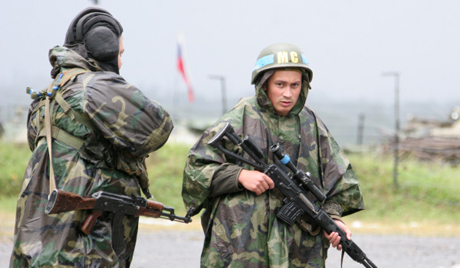
Twenty Years of Russian “Peacekeeping” in Moldova
Twenty Years of Russian “Peacekeeping” in Moldova
Twenty years ago, on July 21, 1992, the Russian 14th Army’s intervention in the Transnistria conflict forced Moldova to accept the deployment of Russian “peacekeeping” units. Six days later (July 28), the first of those units was air-lifted from Russia’s interior to Moldova, on both banks of the Nistru (Dniester) river. Twenty years later, Russian troops both with and without a “peacekeeping” title are still keeping, not the peace in Moldova (Chisinau’s pitiful military is weaker than Tiraspol’s), but keeping the territory for Russia.
Russia’s “peacekeeping” scenarios in Moldova/Transnistria in 1992 and in Georgia/South Ossetia in 2008 contain significant parallels. Each scenario involved a Russian-initiated and –controlled – escalation process, initially through local paramilitary proxies, leading to overt Russian conventional-force intervention.
In both cases, the Russian military already stationed in-theater or in direct vicinity, armed paramilitary insurgents and unleashed them against legitimate state authorities: Moldovan ones in Transnistria, Georgian ones in South Ossetia. The paramilitary stage of the operation, itself escalating from light to heavy weapons use, came close to removing Moldovan authorities from Transnistria (to which Moldovan authorities were still clinging in spring 1992) and Georgian ones from South Ossetia (where Tbilisi-loyal authorities had skillfully rebuilt a presence in 2006-2008). Both Moldova in 1992 and Georgia in 2008 faced imminent, potentially irreversible, and certainly ignominious loss of the territory.
Outmanned and outgunned by Russia’s proxies on the ground, Chisinau in 1992 and Tbilisi in 2008 had no choice but to send in conventional troops to deal with the paramilitary assault on their sovereign territory. Thus, Chisinau and Tiraspol escalated to the conventional-force level. This was the only response available to them, if only because Moldova and Georgia did not have or wish to have any other type of forces; paramilitary warfare by proxy being Russia’s distinct specialty.
Taking seriously the international recognition of their territorial integrity, Chisinau and Tbilisi stated their case accordingly. However, their conventional-force response was improvised under heavy time-pressure in both cases. And in both cases, the Russian military counter-escalated with overwhelming force, promptly ending the fighting on Russia’s own terms. The Russians controlled the escalation process throughout, outmatching the Moldovans in 1992 and the Georgians in 2008 at each rung on the escalation-counter-escalation ladder.
These conflicts exhibit many differences along with similarities overall. The Russian “peacekeeping” paradigm (until 2008 in Georgia, continuing in Moldova) is one of the similarities. This pattern suggests that the Russian military and intelligence services executed some off-the-shelf contingency plans in 1992 and 2008. The Russian government characterizes its 2008 invasion of Georgia’s territory as a case of “coercion to peace” (prinuzhdenie k miru) – a specifically Russian version of “peacekeeping” operations.
On the 20th anniversary of the intervention in Moldova, Russia’s State Secretary and Deputy Foreign Affairs Minister Grigory Karasin wrote: “Attempts to discredit Russia’s peacekeeping operation by claiming that it does not correspond with UN peacekeeping standards, are not even worth discussing.” In the same vein, “conversations [razgovory] about reformatting the peacekeeping operation make no sense without clear agreements to work out Transnistria’s special status, reliably guaranteed.” In common with other Russian diplomats, who reference Moldova’s territorial integrity with decreasing frequency even as a theoretical proposition, Karasin omits to mention it in his retrospective account, although the 1992 ceasefire agreement had paid lip service to Moldova’s territorial integrity (Rossiiskaya Gazeta, July 23).
Karasin directly supervises Russian diplomacy’s work on the Transnistria conflict, personally holding discussions on this with Western and Moldovan counterparts on a bilateral basis (outside international frameworks). On that authority, he lists several pre-conditions to a political solution of the conflict. Casting Russia as protector of the Moldovan ethnic identity against Romanian identity, Karasin introduces the wording “Transnistria’s aspirations to self-determination,” and wants guarantees for “the rights of Moldovans, Russians, Ukrainians” there. Karasin praises the 1997 Primakov Memorandum and the 2003 Kozak Memorandum (naming the documents but not the authors) as valuable proposals for a political settlement, although these documents are anathema to all parties other than Moscow and Tiraspol. He omits any other proposal, except when condemning Moldova’s 2005 law on the principles of conflict-resolution as an insuperable obstacle to resolution. Failing to mention the international 5+2 negotiating format, Karasin insists that Russia is a “guarantor” of implementing any eventual solution – a role long-demanded but never acknowledged or foreseen in the 5+2 or any other format. Karasin insists that Russia’s “peacekeeping mission fully corresponds to Russia’s status as mediator and guarantor of the political settlement of the Transnistria problem” (Rossiiskaya Gazeta, July 23).
All this suggests that Moscow seeks to: bypass the 5+2 negotiations, in which it participates pro forma; throw back the negotiating process to a situation in which Chisinau and Tiraspol are treated as co-equal parties, in a “common state” [confederal] or a “federalized state”; place such a “state” or any solution under Russian political-military “guarantees” (Russia offers to Ukraine to become the second-fiddle “guarantor” – Interfax-Ukraine, July 12); and in the meantime – a long meantime – play ethnic politics in right-bank Moldova and Transnistria in a more intrusive manner than at any time since 1992.


